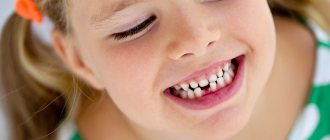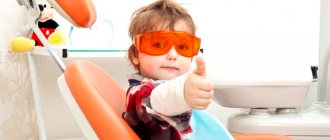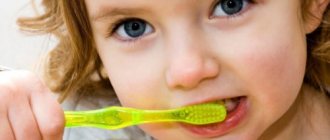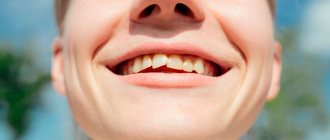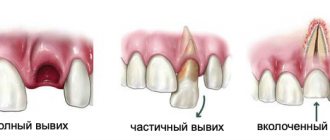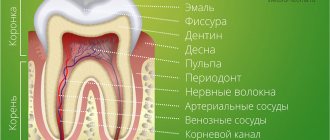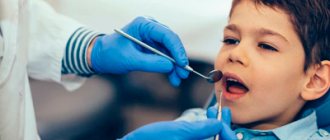What are molars?
They are formed from the epithelial dental plate: molar rudiments appear only by the fifth month of the mother’s pregnancy. They are divided into two types: replacement - incisors, canines and molars, and additional - molars. The first ones repeat similar teeth in the “milk” set, the second ones have no predecessors.
The rudiments of replacement molars grow in the same alveolus as milk teeth, behind the lingual surface, and over time they are isolated by bone tissue. The rudiments of additional ones are formed only after a year, since the jaw by that time increases in size.
Molars are being cut: symptoms
The first characteristic symptom of the beginning of the eruption of molars in a baby is that his jaw begins to increase in size. If the gaps between the baby teeth are quite small, then the body prepares to replace them with permanent ones - it creates all the necessary conditions for the growth of “adult” teeth.
The first molars announce their appearance quite seriously. This period brings the most pain to children and troubles to parents. The child sleeps poorly, becomes capricious, irritable, and may lose his appetite. Symptoms of molar teething may include a runny nose or cough, or an increase in the baby’s body temperature. According to doctors, these are not obligatory signs of eruption of molars; to a greater extent, they appear against the background of a general decrease in immunity and an increase in the vulnerability of the child’s body.
But, in any case, once the child reaches one year of age, parents should carefully monitor the child’s condition, the appearance of the symptoms described above, and act competently to relieve the baby’s unpleasant pain.
An almost obligatory sign of eruption of molars is increased salivation. At the second stage of tooth formation, this symptom is not as pronounced as the first time, but it can also cause inconvenience. By the age of 6-7 years, a child can already be taught to wipe his mouth and cheeks on his own, with a handkerchief or sterile napkins. If this is not taken care of, irritation will appear on his lips, cheeks and chin due to the increased sensitivity of the delicate baby skin (there are many different bacteria in saliva).
The eruption of molars in a child may be accompanied by symptoms such as diarrhea for several days. In this case, loose stools are a consequence of an infection entering the child’s body. The reason for this is that the baby often puts dirty hands or other objects into his mouth; copious salivation contributes to this, regularly washing the intestines. Short-term diarrhea (no more than three times a day) without the admixture of blood bodies is not dangerous for the child. But a doctor’s supervision will not be superfluous, since during this period, with a weakened child’s immune system, a new infection may be added and all symptoms may worsen.
What permanent teeth should children have at different ages?
On average, the timing of eruption does not vary much. In hotter climates this process occurs faster:
- Central incisors - make themselves felt in the period from 5-7 to 6-9 years.
- Lateral - a little later, from 7 to 10-11 years.
- Fangs - on average appear at 12-13 years of age (some experts expand this range to 9-14).
- First premolars - can appear between the ages of 9 and 12-13 years.
- Second premolars – opinions differ regarding these teeth: 9-11, 9-15, 10-14 years.
- First molars are among the earliest: from 5 to 8 years.
- Second molars - in the period from 10 to 15 years, but more often at 12-13 years.
- Third molars - after 18 years (according to various sources, up to 20-25 years).
Researchers give different timing of eruption, since they rely on results from different regions, with different climates, which greatly influences the replacement process.
Parents helping their child when his molars are being cut
The process of erupting molars is long and painful. During these periods, parents should try to be very attentive and tolerant towards their baby. To reduce pain and anxiety, pediatric dentists recommend using special gels that are cooled in teethers.
If your temperature rises or alarming symptoms such as runny nose or cough appear, you should definitely consult a pediatrician. The doctor will determine the exact cause and may prescribe anti-inflammatory drugs.
Teething is a period when increased attention to oral hygiene is required. For this age, you need to choose the right toothpaste for your child. For example, children's toothpaste from the ASEPTA baby series for children aged 0 to 3 years significantly reduces the number of harmful microbes in the child's mouth, so that the difficult period of teething passes without unnecessary hassle.
How many teeth change in children: order of eruption
During the replacement process, the child loses all twenty baby teeth, and 32 permanent teeth grow to replace them. Very often, the child first grows the first molars, which are absent in the primary dentition, and not the central incisors, as is commonly believed. In the future the sequence is as follows:
- lower, and behind them upper incisors in the center of the jaw;
- lateral incisors located above and below;
- 1st premolars;
- fangs;
- 2nd premolars;
- The 2nd and 3rd molars (“wisdom teeth” may never arrive).
It is not by chance that this sequence is laid down by nature. It takes into account the growth rate of the jaw and skull bones, which means that if the order is followed, the correct bite is formed.
What parents should pay attention to
The body prepares for the eruption of milk teeth in infants in advance. Therefore, the first signs are quite easy for mothers and fathers to identify on their own, as the child’s emotional state changes, he is capricious, sleeps poorly, and puts toys in his mouth. In addition, the baby has:
- excessive salivation
- swelling and redness of the gums, accompanied by itching
- increase in body temperature
- loss of appetite
All these symptoms usually disappear after the tooth erupts.
How does the growth process of molars occur?
At 12-13 years of age, a child, as a rule, no longer has milk teeth, although their roots dissolve earlier. At this point, there are part of the molars in the mouth with fully and partially formed roots.
Dental roots go through 2 stages in their development:
- the period of unformed apex (the root is still as long as possible, the walls are parallel, the canal is wide);
- the stage of an unclosed apex (the formation of the apex ends, the walls of the canal come closer together).
The roots of the lower jaw form faster than the upper jaw. This process also has approximate deadlines, but they can shift in both directions. Therefore, it is definitely impossible to answer the question at what age children develop permanent teeth - canines, incisors or molars. As with dairy products, everything is individual here.
Timing of eruption
As a rule, it is almost impossible to determine the exact time of eruption of milk teeth in infants, since the process occurs individually for each child and depends not only on his state of health and genetic characteristics of the body, but on the health of the mother during pregnancy.
Usually the baby's lower central incisors appear first, then the upper central incisors begin to grow. All baby teeth in a child erupt before the age of 2.5–3 years.
According to research, the optimal pattern for teething in infants is as follows:
- 6–9 months – lower central incisors
- 7–10 months – central upper incisors
- 9–12 months – lateral upper and lower incisors
- 12–18 months – upper molars
- 13–19 months – lower molars
- 16–20 months – upper canines
- 17-22 months – lower canines
- 20-33 months - second lower molars
- 24-36 months - second upper molars
At what age do they appear?
The start and end times of the replacement of baby teeth with a permanent set are approximately the same for all children. Slight fluctuations from the average age indicators can be observed among representatives of different regions. It is believed that the hotter the climate, the earlier the child’s molars grow.
The table presents age indicators reflecting the time when teeth from the permanent set begin to erupt according to various authors.
| Dental kit | Age of eruption of molars in a child (in years) | ||
| according to Vinogradova | according to Novak | according to Lukomsky | |
| Central incisors | 5-6 | 6-9 | 6-9 |
| Lateral incisors | 7-9 | 7-10 | 7-10 |
| Fangs | 12-13 | 9-14 | 9-14 |
| First premolars | 9-11 | 9-13 | 9-13 |
| Second premolars | 9-11 | 10-14 | 9-15 |
| First molars | 4,5-7 | 5-8 | 7-8 |
| Second molars | 12-13 | 10-14 | 10-15 |
| Third molars | 18-25 | 18-20 | 15-24 |
Disagreements in the timing of molar eruption according to different authors are explained by the fact that the studies were carried out in different regions and with a difference of several decades.
«
Typical problems.
NORMALLY, the permanent incisors are located “evenly” in the dentition without “protrusion” or “sagging” to the side. This indicates a harmoniously occurring process of physiological replacement of milk teeth with permanent ones.
If there has been early removal of baby teeth in children and, as a result, permanent chewing teeth are displaced forward, improper closure of the dentition occurs and crowding of teeth appears in the area of the frontal and chewing teeth.
A common problem in the period from 9 to 12 years is poor oral hygiene, which is associated with the characteristics of the psychological development of children. As a result, caries develops in “young” permanent teeth. Most often, the 6th chewing teeth (1st molars) are affected in the area of fissures (natural depressions of the teeth located between the cusps of the tooth).
Fissure caries, remaining unnoticed, develops rapidly and is quickly complicated by inflammation of the nerve of the tooth (pulpitis).
PHOTO: The child's lower permanent incisors erupted in the second row. In this situation, it is necessary to free up space by removing the mobile baby teeth so that the permanent teeth can take the correct position in the dental arch.
How long do permanent teeth grow?
There are no exact dates for the growth of permanent teeth; in each case, individual characteristics of the body and hereditary factors play a role.
Time frame for the final formation of the root system of molars:
- incisors located in the center - climb by 10 years;
- lateral incisors - by 10 years;
- fangs - by the age of 13;
- first premolars - emerge by age 12;
- second premolars – 1 to 12 years;
- first molars – by 10 years;
- second molars are cut by the age of 15.
The rate of tooth growth is different for each group. Rapid eruption is observed in the second premolars; in six months they rise by 8 mm. The incisors located in the center rise by 12 mm per year, and the canines grow to 13 mm in two years.
If there is a slight increase over a long period of time, you should see a doctor. Perhaps the child has problems related to the replacement of milk units.
The order of eruption of permanent teeth
At the age of 5-6 years, the replacement of baby teeth with permanent teeth begins.
This is preceded by the growth of the rudiments of permanent teeth and the physiological resorption of the roots of milk teeth. As the roots of the teeth are reabsorbed, mobility of these teeth appears. Children often swing their baby teeth on their own. The first permanent molars behind the last primary tooth (deciduous molar) are usually the first to erupt. Their appearance often goes unnoticed: the teeth erupt behind the milk teeth and their appearance is not accompanied by the loss of milk teeth. Closer to 6 years of age, permanent incisors replace primary incisors. First, the primary incisors on the lower jaw are replaced, and then on the upper jaw. At 7 - 8 years old, permanent lateral incisors begin to erupt on the lower jaw, and at 8 - 9 years old - on the upper jaw.
The formation of the roots of young permanent teeth is completed by 10–11 years.
How many primary and molar teeth does a person have?
In children, the size of the jaw is almost half (in terms of the number of teeth that fit on it) smaller than in adults. Initially, the child has up to 20 teeth - 10 on each jaw. That is, one jaw - 4 incisors, 2 canines and 4 molars. Primary molars have not yet been clearly divided into small and large.
After 16 years, a teenager’s jaws reach approximate sizes that are accessible to an adult. A teenager already has approximately 28-30 teeth, and not 20-24, as before. The number of molars is often represented by 2 small molars and 2 large molars - on each side on each jaw. The last 2 or 4 teeth - “wisdom teeth” usually appear by the age of 20-22 - and a person acquires a full set of teeth, numbering 8 incisors, 4 canines, 8 small molars and 12 large molars - on both jaws in total.
Possible problems with deviations from the norm
Complete edentia is a case when teeth are completely absent.
Regardless of the fact that the molars have just appeared or are about to erupt in the mouth of their beloved child, parents should be vigilant, because there are many dental problems. The main issue is the delay in the growth of permanent teeth (a baby tooth has fallen out, but a new one has not appeared).
The reason may lie in a genetic predisposition or edentia, which arose due to a violation of the formation of rudiments during intrauterine development. If there is no way to influence the situation, the child is indicated for prosthetics.
When permanent teeth erupt, another problem may arise – pain. This is most often due to thin, not fully formed enamel, which does not have sufficient mineralization. It is at this stage that the tooth is susceptible to various diseases, in particular caries.
With deep destruction of dental tissues, even more serious diseases develop: pulpitis, periodontitis. Therefore, you cannot ignore a child’s toothache; you need to make an appointment with a pediatric dentist as soon as possible.
At the very beginning of the growth of permanent teeth, other problems can occur:
- loss of a root unit is a signal of serious problems with the child’s health;
- an increase in the level of trauma - the active lifestyle of children during the period of maturation of molars often leads to injury to the incisors and canines, and attempts to chew hard objects end in the breakage of molars and premolars.
Each case requires the intervention of a specialist to eliminate the negative consequences.
